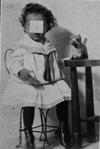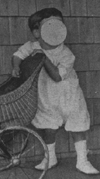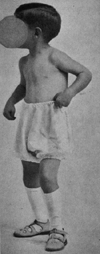NEONATOLOGY ON THE WEB
Premature and Congenitally Diseased Infants
by Julius H. Hess, M.D.
Chapter XX
The Future of the Premature Infant
The early small, thin face with its mass of wrinkles in the
presence of proper feeding soon becomes rounded out by the deposit of
layers of fat, the skin becomes smoother and the face more nearly
like that of a normal nursling. There, however, remains for a more or
less indefinite period a prominence of the sucking cushions greater
than that seen in the normal infant. The enlargement of the tongue
may be noted until toward the end of the first year. The same may be
true of exophthalmos. The small stumpy nose may also retain its
characteristic appearance until the end of the first year. The "doll"
type of face is also usually present until after the fourth or sixth
month of life.
The infants often show the adenoid appearance, due to the small
nose, with its tendency to the development of a posterior rhinitis,
and the large tongue. This appearance is lost as the megacephalus
disappears.
The other characteristic physical changes, which are evidenced by
a short neck, a long, broad trunk, with a deeply seated navel and
short legs, and which can usually be noted by the second to fourth
month of life, gradually disappear during the second year.
The question is often asked as to what is the ultimate outlook for
prematurely born infants who live beyond the first year of life. It
is desired to know (1) if they suffer from a higher mortality in
early childhood than the full-term infant, and (2) are those that
survive normal mentally and physically. In order to answer these
questions in the proper way it is necessary to observe the children
over a period of years. With institutional children this is often
impossible and even in private practice difficult. Usually one must
satisfy himself with comparisons at the end of the first year. For
this comparison the full-term normal child is used as a basis, but as
Pfaundler says, only those who have been similarly fed and raised
under the same hygienic conditions can be fairly contrasted.
One observes with the premature as with the full-term child that
the breast-fed infants raised among good home surroundings have a
lower mortality that the same in institutions, and that the
artificially fed have a greater mortality than the breast fed.
Ostreil gives the statistics from the Prague Maternity on 1542
illegitimate prematures. The total mortality of these infants was
52.7 per cent. Of these cases 814 were followed for nine, ten, and
eleven years. Of this series 86.6 per cent are living, but these
figures include those in whom there was no indication of syphilis,
those who received breast milk after leaving the institution, and
those weighing up to 2800 gm. Those under 2500 gm. weight and 45. cm.
length, who left the institution alive and had, therefore, survived
the first weeks, were 86 in number, of which 38 were boys and 48
girls. Of these 51 were alive at the end of the first year, 23 boys
and 28 girls, a mortality of 40.7 per cent, or 39.5 per cent for
males and 41.7 per cent for females.
Oberwarth's results are shown in tabulated form below. He followed
for more than a year 12 infants who weighed less than 2000 gm. and
who were, with 2 exceptions, illegitimate and raised under poor
hygienic conditions.
|
Entrance
|
Later examination
|
General physical development
|
Mentality
|
|
Length, cm.
|
Weight, gm.
|
Age
|
Weight, gm.
|
Length, cm.
|
|
46.0
|
1880
|
17 mos.
|
10,750
|
79
|
Good; has eight teeth, walked at fifteen mos.
|
Normal
|
|
43.6
|
1890
|
17 mos.
|
10,250
|
77
|
Walks alone
|
Normal
|
|
43.3
|
1960
|
24 mos.
|
9,700
|
75
|
Good; has twelve teeth; walked at fifteen mos.; has a
congenital hip dislocation
|
Very good
|
|
41.5
|
1460
|
30 mos.
|
9,750
|
77.6
|
Rachitis; anemia; congenital hip dislocation
|
Normal
|
|
40.0
|
1750
|
40 mos.
|
10,900
|
80
|
Severe rachitis; not walking
|
Backward
|
|
44.0
|
1820
|
54 mos.
|
15,000
|
95
|
Very good
|
Very good
|
|
41.5
|
1710
|
60 mos.
|
10,900
|
86
|
Anemia; large head; convulsions
|
Good
|
|
|
1250
|
66 mos.
|
13,900
|
103
|
Flat occipital region
|
Fair
|
|
44.2
|
1980
|
6.5 yrs.
|
14,400
|
101
|
Anemic
|
Nervous
|
|
42.5
|
1710
|
6.5 yrs.
|
17,000
|
106
|
Anemic for eleven mos.; now 100 per cent hemoglobin
|
Normal
|
|
41.0
|
1500
|
6.8 yrs.
|
16,700
|
109
|
Rachitic deformities
|
Backward
|
|
45.5
|
1950
|
8.2 yrs.
|
21,300
|
123
|
Good
|
Normal
|
A comparison of these results with those attained with a similar
group of full-term infants reflects with credit on the future
development of the premature. The tendency to anemia and the results
of rachitis, to both of which the premature is frequently subject,
are not uncommonly seen in the early years of childhood. Whether the
lack of resistance is a result of the shortening of the period of
intra-uterine nutrition, or whether it is due to extra-uterine
factors, more especially underfeeding and improper care during
infancy cannot be stated, but we are inclined to believe that the
former factor outweighs the latter.
According to Feer, many infants overcome their handicaps and make
good progress, so that by the end of the second or third year their
measurements are about the same as those of the normal child. Some,
however, do not do as well as this, showing tendencies to rachitis,
spasmophilia and especially anemia. The pallor developing toward the
end of the first year depends in many instances upon the lack of iron
deposits which are made in great part during the last few months of
intra-uterine life; in other instances it depends upon a lack of
development of the blood-making organs.
Wallich and Fruhinsholz analyzed the previous history of older
children and adults and also ascertained the later history of the
prematurely born. Possibly the earliest instance of prematurity on
record is that of the Professor at Padua who was born at the end of
the seventh month and lived to be eighty. Other famous prematures
include Newton, Rousseau, Voltaire, Cuvier, Victor Hugo, Lamartine
and Renan.
The outlook for the future of the premature is shown to depend in
a large measure upon the degree of development at birth, as evidenced
chiefly by the weight. Of 17 infants weighing between 900 and 1500
gm., studied by Wallich and Fruhinsholz, 41.1 per cent developed into
normal adults, a similar percentage were but slightly handicapped,
while the balance were much below normal. Of the 25 weighing between
1500 and 2000 gm., 52 per cent were normal and 36 per cent slightly
handicapped. Of the 36 between 2000 and 2500 gm., 75 per cent were
normal and 22.2 per cent retarded. The last group comprised 65
weighing from 2500 to 3000 gm. of which 78.4 per cent were normal and
20 per cent somewhat under the normal.
The same authors traced back to birth the history of 180 children
from Broca's surgical clinic and 620 inmates of the asylum for the
epileptic and feeble-minded. Twelve per cent of the former and 8 per
cent of the latter were known to be of premature birth. Thus we see
that a large percentage of the prematurely born develop normally in
both mind and body, while the balance exhibit varying degrees of
inferiority, hernias, club feet, enuresis, pavor nocturnus, etc.
These signs of degeneracy are seemingly the result of prematurity and
of the trauma sustained at the time of delivery.
The studies of Ylppö on the development of the premature from
infancy to the school age led him to make certain generalizations.
The growth of premature infants (those with a weight below 2500 gm.)
discloses a considerable derangement in the first three to five years
of life. This discloses itself in that the weight, skull and thorax
growth in almost all this class is slower. This retardation in growth
is the more marked, the less the body weight and length.
Growth disturbances appear immediately after birth and are
proportionately more marked in the first six to twelve extra-uterine
months of life. At the end of two to four years there begins a
gradual equalization, which in most instances ends at about five or
six years. From this period on the curves of growth are parallel with
those of full-term children. Only in the case of very small
prematures with a birth weight of 1000 gm., the reparation does not
seem to be completed by the age of five to six years. The growth in
length is up to this time disturbed approximately to the same extent
as the mass growth.
The chest, which is proportionately deficiently developed in
prematures, also shows on the average, until the age of three years a
retardation in growth. In the years following, the breast
circumference, however, reaches practically the same value as in
full-term children of a similar age. The cross-section of the chest
of the premature approaches more the form of an ellipse than a
circle. The cross-section area is in the smallest prematures
strikingly small in comparison with the body length. The growth of
the head is the least disturbed or retarded. This is explained by the
fact that the brain growth in premature follows certain individual
laws without depending, as a rule, on the development of the body.
The principal point of these growth disturbances in the premature
is immaturity. The more immature an infant is born, the more
deficient is the function of the various organs in extra-uterine
life. Especially in the province of digestion are variations noted in
prematures, because of poor utilization, particularly of fat and
salts, a qualitative nourishment results which favors the development
of growth disturbances.
Besides these and other exogenous factors, certain endogenous
factors probably play a passing but noteworthy part in the production
of growth disturbances. All these defects, however, gradually
disappear or are overcome, so that reparation is completed by the
time the premature reaches the school age. From this time on the
growth again turns back to the paths which have been designed for the
hereditary mass of the child.
Ylppö was able to follow up 89.52 per cent of his cases and
thus compiled his figures for the mortality and future development of
the premature.
Infants with a Birth Weight Up To 2500 Gm. In
Their First Eight Years
|
Year of Birth
|
Total No.
|
Not followed up, per cent
|
Followed through
|
In 1918 at end of year of life
|
Of these still alive, per cent
|
Of these dead, per cent
|
|
1918
|
48
|
---
|
48
|
1/2
|
16 = 32.65
|
33 = 67.35
|
|
1917
|
57
|
2 = 3.51
|
55
|
1
|
35 = 63.64
|
20 = 36.36
|
|
1916
|
98
|
3 = 3.06
|
95
|
2
|
46 = 48.42
|
49 = 51.58
|
|
1915
|
90
|
5 = 5.56
|
85
|
3
|
42 = 49.41
|
43 = 50.59
|
|
1914
|
101
|
11 = 10.89
|
90
|
4
|
40 = 44.44
|
50 = 55.56
|
|
1913
|
85
|
13 = 15.29
|
72
|
5
|
30 = 41.67
|
42 = 58.33
|
|
1912
|
83
|
10 = 12.05
|
73
|
6
|
30 = 41.10
|
43 = 58.90
|
|
1911
|
57
|
16 = 28.07
|
41
|
7
|
19 = 46.34
|
22 = 53.66
|
|
1910
|
48
|
10 = 20.83
|
38
|
8
|
20 = 52.63
|
18 = 47.37
|
|
Total
|
668
|
70 = 10.48
|
598
|
|
278 = 46.49
|
320 = 53.51
|
These statistics show that only 40 to 45 per cent of the premature
infants lived to the school age. Twin prematures showed a somewhat
better average -- 50 per cent.
Twins With A Birth Weight Up To 2500 Gm. In Their
First Eight Years
|
Year of Birth
|
Total No.
|
Not followed up, per cent
|
Followed through
|
In 1918 at end of year of life
|
Of these still alive, per cent
|
Of these dead, per cent
|
|
1918
|
9
|
---
|
9
|
1/2
|
5 = 55.56
|
4 = 44.44
|
|
1917
|
14
|
---
|
14
|
1
|
10 = 71.43
|
4 = 28.57
|
|
1916
|
26
|
---
|
26
|
2
|
15 = 57.69
|
11 = 42.31
|
|
1915
|
15
|
---
|
15
|
3
|
7 = 46.67
|
8 = 53.33
|
|
1914
|
18
|
5 = 27.78
|
13
|
4
|
7 = 53.85
|
6 = 46.15
|
|
1913
|
14
|
---
|
14
|
5
|
7 = 50.00
|
7 = 50.00
|
|
1912
|
11
|
2 = 18.18
|
9
|
6
|
4 = 44.44
|
5 = 55.56
|
|
1911
|
11
|
3 = 27.27
|
8
|
7
|
7 = 87.50
|
1 = 12.50
|
|
1910
|
10
|
2 = 20.00
|
8
|
8
|
6 = 75.00
|
2 = 25.00
|
|
Total
|
128
|
12 = 9.38
|
116
|
|
68 = 58.62
|
48 = 41.38
|
In concluding it may be said that the future of the prematures who
survive is on the whole good. They seem to be somewhat more subject
to hydrocephalus and to psychic and nervous anomalies, such as
enuresis and night terrors, and to anemia, rachitis and spasmophilia.
Many are precocious, even original children. They tend to remain
light in weight and short in length, but this is usually equalized by
the time of entering school.
It is generally the case that in those infants who survive, most
differences between the premature and the full-term child have
disappeared by the time of puberty, and therefore every effort should
be made to preserve all perfectly developed premature infants.
Walking and Talking
It is well known that in premature infants we may not expect the
development of certain faculties, namely, speaking and walking, at
the same time as in full-term infants. Wall states that his premature
infants learned to talk seven and a half months later and learned to
walk six months later than full-term children. He also reports that
certain speech defects, as stuttering and stammering, occurred more
frequently in his prematures. These differences, however, became
equalized later on.
In general, the smaller the premature at birth, the greater is the
delay in its learning to talk. It is rather an exception to the rule
when infants that have been born weighing 1000 to 1500 gm. learn to
talk before they are two years old. The following table shows when
children of Yllpö's series learned to walk and to talk a few
words:
The age and number of children when they were able to speak:
|
9 months to 1 year
|
3
|
|
1 year
|
9
|
|
1 year, 3 months
|
48
|
|
1 year, 6 months
|
18
|
|
1 year, 9 months
|
54
|
|
2 years, 3 months
|
1
|
|
2 years, 6 months
|
10
|
|
2 years, 9 months
|
1
|
|
3 years, 6 months
|
1
|
|
4 years
|
1
|
|
Unknown
|
37
|
The age and number of children when they started to walk:
|
9 months to 1 year
|
3
|
|
1 year
|
15
|
|
1 year, 3 months
|
46
|
|
1 year, 6 months
|
52
|
|
1 year, 9 months
|
28
|
|
2 years
|
25
|
|
2 years, 3 months
|
8
|
|
2 years, 6 months
|
4
|
|
2 years, 9 months
|
2
|
|
3 years
|
4
|
|
3 years, 3 months
|
1
|
|
4 years
|
1
|
|
Unknown
|
26
|
The statements as to the time at which the child spoke the first
words, and when it started to walk vary widely in individual cases.
Only intelligent mothers are able to make reliable statements
pertaining thereto. On the other hand the delay in learning to talk
and to walk depends in many cases not upon the docility or
development of the infants, but upon the efforts of its mother or
nurse.
From the preceding facts it follows that the small prematures
learn the first sounds and the first words on an average of one year
and six months. This occurs then about six months later than in
full-term infants. The age at which the child learns to walk is about
the same as that at which it learns to talk. This may be regarded as
a proof that learning to walk depends in a healthy child upon its
mental development.
Constitutional Inferiority
The various lesions, either of traumatic nature, due to delivery
itself or extra-uterine life, brought on by deficient resistance or
deficient functional capacity of the different organs, result in
various clinical symptoms, which have been designated under the
collective name "constitutional inferiority." Everything seems to
point to the fact that this constitutional inferiority in the strict
sense of the word does not occur in a much higher degree in premature
infants than in full-term children, if we do not include the various
gross anatomical malformations.
We have reason to assume that many prematures who remain weaklings
in their later life and show other signs of inferiority, suffered
from some constitutional anomaly, intra-uterine, or post-natal
trauma, or were born in a state of physiological immaturity. This
view seems to be especially strengthened by the fact that the more
premature and the smaller the infants come to the world, the more
frequently they suffer with idiocy, Little's disease, serious
anemias, rachitis and other diseases based upon the condition of
deficient resistance.
The proportional diminution of various pathological symptoms with
increasing birth weight would be difficult to understand in terms of
congenital constitutional lesions. Also the frequent disturbances of
growth in premature infants, especially during the first years of
life, have some connection with this passing poor condition of the
premature. Later, strikingly good reparation of the growth
disturbances shows best that this state is not dependent upon
congenital constitutional factors.
The Mental Development of the Premature Infant During Early
Childhood
In order to review this subject properly, it is necessary to
divide premature infants into two large groups: (1) Prematures
without pathological changes; and (2) those born with pathological
changes due to constitutional diseases and congenital malformations.
In the well-developed fetus which has not been damaged during the
time of conception, and which is born at an age compatible with a
physiological development necessary to meet its needs for life and
which suffers no undue traumata during or following birth, a normal
mental development may be expected. External influences will affect
its mental growth as well as its physical development, therefore, it
must be raised in a suitable environment and be judiciously fed. It
may be stated that the longer the intrauterine life of the fetus, the
less the dangers of interference with its normal mental growth. It is
quite natural to expect, therefore, that these immature infants are
more subject to mental disturbances and defects than the full-term
infant. Abnormalities in development need not be explained by
anomalies in the embryo, but rather may be due to direct external
traumata of a mechanical, dietetic and of an infectious nature. Thus,
there remains no other choice than to make the intra-uterine and
extra-uterine noxae responsible for the frequent cerebral
disturbances, be they connected with spastic states or idiocy, with
or without spasms.
It is our experience that the majority of premature infants born
after the thirty-second week into a proper environment without birth
injuries, undergo a normal mental development. That these individuals
are more subject to rickets, anemia and spasmophilia with their
consequent effects on the nervous system is not to be forgotten. But
all these conditions are amenable to therapeutic procedures with only
a limited after effect.
In the second group belong those suffering from constitutional
diseases and congenital malformations. These individuals cannot be
classified in groups as to their future development, but each one
must be considered individually. While congenital lues usually leaves
its mark in the full term, in the premature it is even more grave in
its consequences. However, much can be expected from proper and early
therapeutic measures. In those suffering from hemorrhages into the
cerebrum and spinal cord, it is easy to understand that in the
premature infant that has survived in spite of these lesions sequelae
may manifest themselves in later life. We would especially impress
upon the physician the fact that not all infants with cerebral
hemorrhages die in the first days of life but that many survive.
Cerebral hemorrhage may not be suspected until late mental and
physical signs develop.
The prognosis in this group must always be made with considerable
reservations.
However, on the whole, it may be stated that mental development
goes hand in hand with physical development. To this broad statement
there are, however, many exceptions, and while we do see a number of
these infants with good physical development who are of low-grade
mentality, in our personal experience we have come in contact with a
larger group of premature infants with a high grade of mental
development, even to the point of precocity. They tend to remain
light in weight and short in length, but this is usually equalized by
the time of entering school.
|

|
Fig. 184. Infant born at thirty-six weeks. Birth weight,
1500 gm. Intense icterus, melena, double inguinal, lumbar,
and umbilical herniae. Photograph taken at six months. Still
showing evidence of megacephalus.
|
|

|
Fig. 185. Same child, aged two and one-half years.
|
|

|
Fig. 186. Same child, aged four and one-half years.
Megacephalus has entirely disappeared.
|
|

|
Fig. 187. Infant born at thirty-four weeks. Complication,
spastic diplegia.
|
|

|
Fig. 188. Child shown in Fig. 187, showing standing
posture.
|
|

|
Fig. 189. Child shown in two previous illustrations,
showing good results following tendon transplantation.
Mental development in advance of age.
|
Return to the Hess Contents Page
Created 4/19/97 / Last modified 4/20/97
Copyright © 1998 Neonatology on the Web / webmaster@neonatology.net





